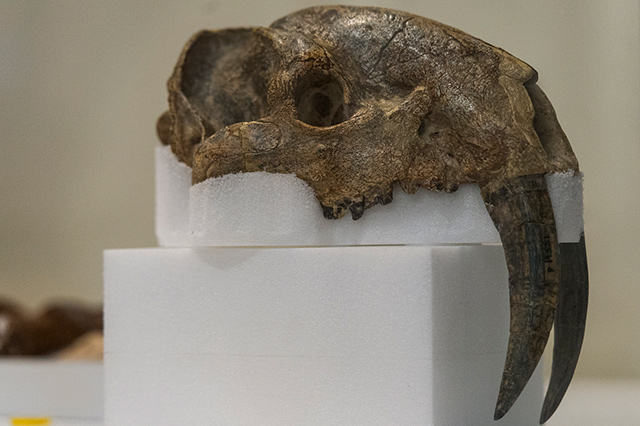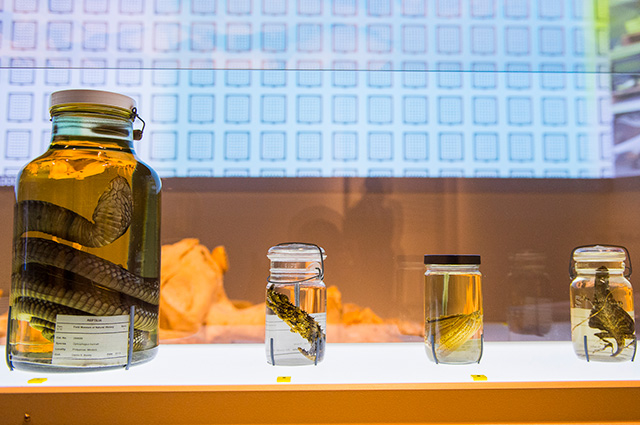Water 'Monsters', Crime-Solving Moss & More Tell Their Secrets At The Field Museum's 'Specimens'
By Sponsor in Arts & Entertainment on Apr 4, 2017 5:00AM
The first gobsmacking pearl of knowledge that you encounter in Specimens: Unlocking the Secrets of Life—the Field Museum's first curated peek behind the curtain into its massive collection of fossils and rare natural artifacts—is one of extreme size and scope.
The Field is home to over 30 million specimens and artifacts, most of them tucked out of view in the bellies of the museum, nestled above and below the familiar exhibition halls. But whether it's a crime-solving patch of moss or the final piece of a decades-long classification puzzle for an ancient, Illinois-native water "monster," it's that seemingly limitless capacity for "aha!" moments inscribed in these artifacts that truly dazzles in Specimens.
Still, volume is key to unlocking those discoveries. Let's take that monster. We found it slightly heartening to learn that, for decades, researchers struggled with the same question we laymen did upon meeting the otherworldly-looking micro-beast known as the Tully Monster: what on Earth is this thing? The museum has more than 2,000 specimens of the ancient Tully Monster—plucked from Mazon Creek fossil site, roughly 70 miles southwest of Chicago. (They've only ever been found in Illinois.) And it needed them all to answer that question. "No single fossil shows all the features clearly," Marie Georg, Exhibition Developer, told Chicagoist. After decades of "uncertain classification," only recently were scientists able to finally determine from the collection that the Tully Monster was a jawless vertebrate, akin to those equally nightmare-fueling toothy bloodsuckers, the lampreys.

(Tyler LaRiviere/Chicagoist)
For more testimony to the power of numbers, meet Harry Nelson. Cutting the very image of the eccentric scientist with his prodigious ponytail and dapper bolo tie, the late Field member collected 600,000 beetles in 6,000 streams, many in the upper Midwest. But Nelson's wherewithal to track where he didn't find the critters was just as key. That extra layer of data becomes key because "we can use that information to find where beetles are now, compare it to where they disappeared from, and start to look at why that might be the case," Georg said.
Speaking of measuring sticks, Specimens boasts a few whoppers. The most eye-grabbing are the vertebrae and sacrum of a Brachiosaurus, unearthed in 1900 in Colorado. It's also the holotype, or the barometer, if you will—meaning, if you think you've discovered remnants of a Brachiosaurus dinosaur of your own, this is the actual specimen by which you'd have to gauge. Among other holotypes on display are the Field's headline-making Olinguito, a raccoon family mammal, native to Colombia and Ecuador, that—a bit mind-bogglingly—wasn't formally "discovered" until 2013. It was the first identification of a new carnivore mammal in the Americas in 35 years. And the one at Specimens is "the one that carries the name," as Georg puts it.
There are even a few specimens that have carried their name to the very end of the line. For example, the Xerces butterflies on display—once plentiful around San Francisco, but extinct since the early 1940s due to urban development—are part of handful that you will literally find nowhere else in the world.

(Tyler LaRiviere/Chicagoist)
There's a broader practicality at play, too—one that extends well beyond the walls of natural history. That case of mounted African squirrels and fruit bats? They're a fraction of the 600 that were gathered alongside staff from the Center for Disease Control (CDC) in the Democratic Republic of Congo on a 2013 trip to isolate the source of monkeypox. The CDC can use blood samples from those little fellas to help track how diseases move through populations.
Then there's what you might call CSI: Museum Campus. Testimony from the Field Museum's Head of Botanical Collections—and his analysis of moss-fragment matches between grave sites—helped lead to the conviction of two people involved in the gruesome Burr Oak cemetery scandal. Four people were alleged to have dug up graves, dumped the bodies and reused the plots. "You never know when and how something is going to be put to use," Georg said.
On a similar wavelength is the "SWAT team concept," as one scientist calls it, that Field staff employed to identify thousands of small mammal fossils gathered decades ago in caves in southern Australia. They recently reached out to a researcher from outside the institution and built a small army of identifiers to catalog the overwhelming haul. No, the effort didn't solve a crime, but the implications could be even bigger, in terms of wildlife restoration. "How can you restore something if you don't know what it was like?" says Bill Simpson, Collections Manager of Fossil Vertebrates. "This is a document of what [the ecosystem] looked like 20,000 years ago."
Despite the collection's aggregate age, these Specimens remain defiantly alive and kicking, with millennia of stories awaiting an audience.
Specimens: Unlocking the Secrets of Life is open at the Field Museum now through January 18, 2018.
This is a sponsored collaboration between the Field Museum and Gothamist staff.